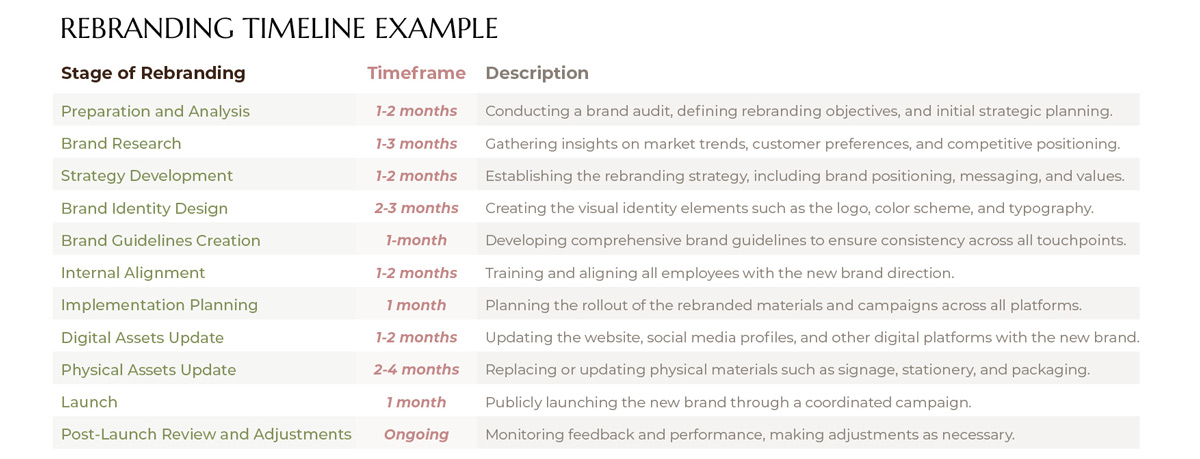No matter how effective your strategy is, it won't bring the intended results if you fail to execute it on time. Crafting a complete rebranding timeline is essential for the success of the rebranding effort. An efficient timeline sets the stage for the rebranding launch and ensures that every step—from the initial concept to the final reveal—resonates precisely.
Failing to develop an efficient rebranding timeline can turn the results around. The project could spin out of control, leading to missed deadlines, blown budgets, and brand fragmentation. This article provides a complete guide to developing an efficient timeline covering the rebranding project.
You will learn how to allocate time to develop a successful rebranding strategy, manage time and resources for branding, and ensure a smooth execution of each step from your rebranding checklist. So, let's get into it!

Rebranding Timeline Development
The most effective approach to developing an effective timeline is to divide the project into multiple phases. By dividing the timeline into different stages, you can allocate sufficient time for each step and ensure the project runs smoothly. This approach offers the following main benefits:
- Teams can concentrate on one aspect of the rebrand at a time, reducing the risk of overlooking critical elements.
- It allows for a more efficient allocation of resources, including time, budget, and personnel, as each phase will have its requirements.
- Phases create natural milestones to measure progress and success, ensuring the rebrand stays on track.
- Breaking the process into phases helps identify potential risks and challenges early, allowing for timely interventions and contingency planning.
- It provides clear communication points for engaging stakeholders, keeping them informed and involved throughout the rebranding journey.
- If unexpected issues arise, adjusting a single phase is more accessible without derailing the timeline. This flexibility can be crucial for the dynamic nature of rebranding.
- There's a more significant opportunity for quality assurance checks, ensuring that every aspect of the rebrand meets the desired standards before moving on to the next.
Preparation Before the Rebrand
During this initial rebranding phase, companies must focus on factors like gathering insights from market data, conducting brand audits, and conducting competition analysis. It is the most crucial phase as it guides the whole brand strategy. Therefore, companies must carefully plan the starting phase. Generally, a complete rebranding process will take between 2 to 12 months. Thus, companies must develop their timeline according to the scale and scope of their brand strategy.
Research and Strategy Formulation
In-depth research is the backbone of an effective strategy. Therefore, companies must give ample time to formulate brand research and strategy. Ideally, the brand research can take anywhere from 2 to 3 months, depending on the type of rebranding the company wants to undergo.
Companies can leverage the latest data collection and analysis methods, such as artificial intelligence, to speed up the process. After conducting thorough market research and brand audit, the strategy formulation phase can take an additional 1 to 2 months. As mentioned, it can vary widely depending on the scope and scale of the rebranding effort.
Sometimes, gathering information through surveys, interviews, focus groups, and competitor analysis may take longer. Since each step requires careful planning and execution, under such conditions, it may exceed the 2 - 3 months time frame.
Design and Brand Asset Development
Brand asset development is another essential stage of rebranding. Since design elements are crucial for visual identity, rushing this stage can lead to costly mistakes and a disjointed brand image. Companies must carefully allocate time to this phase according to their plan.
Ideally, it takes 2 - 3 months during a brand refresh as it may include primary assets like fonts, colors, etc. At the same time, a complete rebrand may take longer, up to 9 months. Because during a full rebrand, a company may change its company logo design, packaging design, website, and marketing materials simultaneously.
As the new logo becomes more complex with multiple formats, sizes, and colors, their creation time increases. The following are some of the other reasons that usually cost companies a lot of time and how companies can avoid them:
- Scope creep: as tempting as it is to add more elements, stick to your initial priorities to avoid delays.
- Revision loops: Establish a transparent feedback process with designated decision-makers to streamline the revision process.
- Vendor delays: Research and communicate clearly with external partners to avoid last-minute surprises.
Internal Alignment and Brand Guidelines Creation
When creating an effective rebranding timeline, companies must carefully allocate time to create brand guidelines and internal alignment. It is necessary to build a cohesive brand voice and enhance brand positioning. Internal alignment may typically take 4 to 8 weeks.
During this phase, it’s necessary to engage key stakeholders across various departments to educate and rally them around the new brand direction. This ensures that everyone within the organization understands and is committed to the rebrand and ensures a unified brand experience.
On the other hand, developing the brand guidelines can take approximately one month, again depending on the complexity and depth of the elements involved. Creating a comprehensive brand style guide is necessary as it outlines how to represent the visual and communicative aspects of the brand across all touchpoints.
Common challenges that may require more time in these stages include:
- The complexity of brand elements
- Gaining consensus from critical stakeholders in larger organizations may lead to prolonged discussions.
- Keeping everyone on the same page. Ensuring that all employees understand the new brand guidelines
- Resistance to change and embedding the new brand ethos within the company culture.
Recommendation: We've developed our Brand Snapshot™ which works as a succinct starter set of brand standards, a great place for small businesses to start if you are short on budget and time. Take a look.
Executing the Rebranding Strategy
Crafting a compelling rebranding strategy is not sufficient to guarantee success. Companies must also know how to implement their new brand strategy on time effectively. Therefore, including a dedicated section for the execution phase in a rebranding timeline becomes crucial.
The success of this phase relies on a well-planned timeline that ensures the cohesiveness of all rebranding components. According to Forbes, launching a rebranding strategy takes 12 to 18 months on average. It includes business approval and a full-fledged launch.
Implementing the Rebranding Strategy
On average, it takes around 12 months to implement the rebranding strategy across all touchpoints properly. Challenges during this phase include coordinating the rollout across multiple channels. Companies may also face difficulties when ensuring consistency and managing stakeholder expectations.
Supply chain delays can affect the availability of the new packaging. Technical issues might hinder the web design, potentially extending the timeline. Search engine and social media algorithm updates can tarnish digital marketing efforts. Such challenges may cause delays, but companies can successfully overcome these issues with careful planning and flexibility.
Public Launch and Marketing Material Update
The Public Launch and Marketing Material Update phase typically spans 1 to 3 months. A successful rebrand hinges on aligning new marketing material with the refreshed brand positioning, which can be complex. Challenges include ensuring all materials, from digital ads to print collateral, cohesively reflect the updated brand identity.
Delays may occur due to the iterative design process, production times, or aligning the launch with strategic timing for market impact. These factors can stretch the timeframe, but when executed well, they solidify the rebrand's success and market presence.
Post-Launch Activities
Launching a successful rebranding strategy is only half of the work done. Companies must have a complete benchmark system to measure the success of the new brand strategy. They must ensure the new brand identity perfectly resonates with the target audience. Under such conditions, an excellent rebranding timeline must also have proper time for post-launch activities.
It helps companies to measure the impact of the brand change and bring opportunities for further enhancing the brand value. Everyday post-launch activities include:
- Measure Impact: Assess the effectiveness of the rebrand against objectives and KPIs.
- Refine Strategy: Make data-driven adjustments based on customer and market feedback.
- Maintain Consistency: Ensure alignment with the new brand identity across all platforms.
- Build Brand Equity: Strengthen the brand's position in the market by reinforcing the new messaging and visual identity.
- Foster Brand Advocacy: Encourage customers and employees to become brand ambassadors, further amplifying the rebrand's reach.
Monitoring and Adjusting the Rebranding Effort
Monitoring and adjusting the rebranding effort is an ongoing process that may continue well beyond the initial launch, sometimes lasting for several months to a year.
This phase is crucial to gather relevant reviews and feedback to evaluate how the new brand messaging connects with the target audience. Companies track customer responses, sales data, and market performance to identify areas where the rebranding effort may need refinement.
During this phase, a few challenges may arise, which could impact the timeline of the rebranding project. For instance, extensive market research may be required to gather insights that can be acted upon, or it may be discovered that misalignments in the company's brand messaging require significant adjustments.
The duration of this phase may vary as it depends on the continuous feedback cycle and how quickly a company can implement the necessary changes to optimize the rebranding effort.
Ensuring Brand Consistency and Brand Recognition
Ensuring brand consistency is a critical factor in achieving brand recognition. Consistency across all touchpoints – from website quick links to marketing collateral – reinforces the brand identity and helps customers quickly identify and remember the brand. Maintaining a uniform look, feel, and tone in messaging ensures that the brand is immediately recognizable, which can build trust and loyalty with the audience.
Brand recognition, in turn, is the result of sustained brand consistency. When a brand is consistently presented, it becomes more familiar to consumers, making it more likely that they will think of it when considering relevant products or services. This recognition is a crucial driver of customer preference and can influence purchasing decisions, ultimately contributing to a company's success and growth.

What to read next: This article outlines the basic strategy for how to roll out a rebrand
Don’t want to miss out on our articles and insights?
Sign up for the Miss Details newsletter today.



